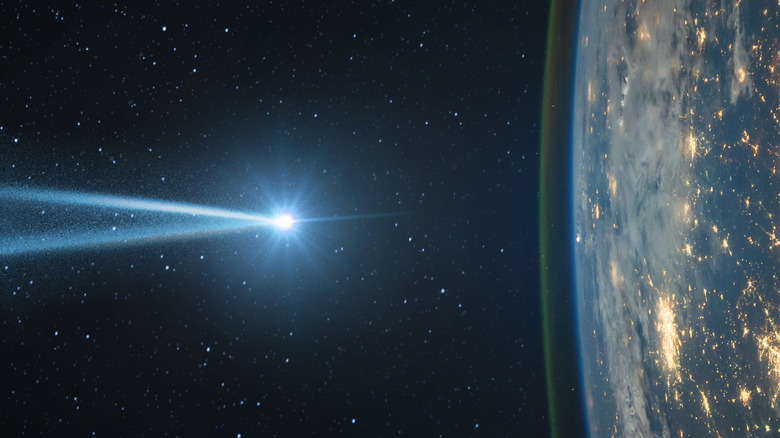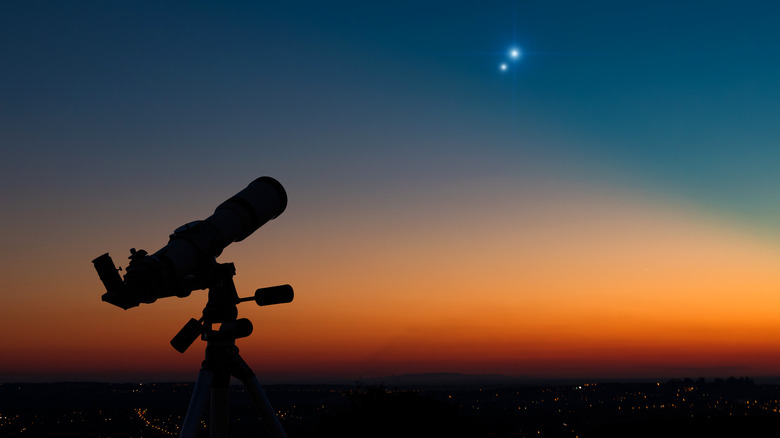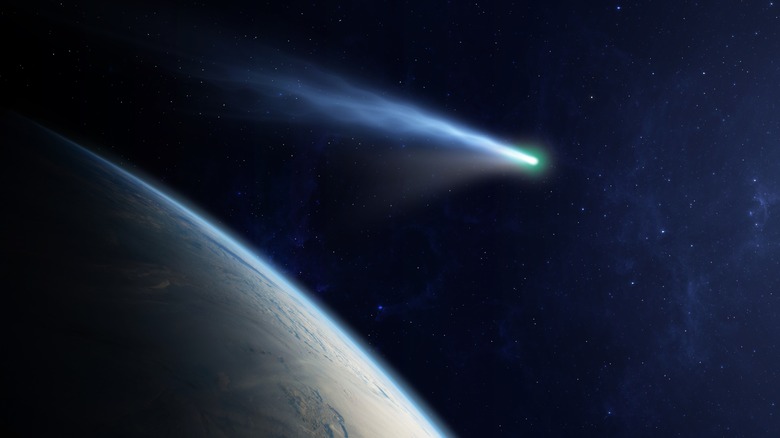The US Just Confirmed The First Interstellar Meteor - Here's What That Means
In early 2014, astronomers tracked a small meteor that entered the Earth's atmosphere and crashed onto the planet's surface a few miles off the coast of Papua New Guinea. The meteor is called CNEOS 2014-01-08, with the last few digits of its name referring to the date of its crash and CNEOS standing for Center for Near-Earth Object Studies.
The meteor is estimated to have measured just over 3 feet in size, though most of it burned up with intense amounts of energy in the atmosphere, leaving only some pieces of debris to end up in the Pacific Ocean. While the CNEOS 2014-01-08 crash was initially considered a "normal" meteor strike, Harvard University professor Abraham Loeb and then-undergraduate Amir Siraj would later discover something really interesting about the origins of this little space rock, as Siraj explained in an article in Scientific American.
Unclear origins
Following studies conducted by Siraj and professor Loeb, it became increasingly evident that CNEOS 2014-01-08 did not originate in our solar system. This is quite unlike the average meteor, which is typically a small block of rock and ice sourced from somewhere within our pocket of the universe. Instead, the two claimed this object came from another solar system, which put CNEOS 2014-01-08 in a category of extremely rare meteors called interstellar meteors. While there were logical reasons behind the duo's proposal that CNEOS 2014-01-08 had interstellar origins, they had a difficult time convincing the scientific community because of a lack of comprehensive data.
Making things more difficult for the scientists was the fact that the only piece of reliable data that would convincingly prove the meteor's interstellar origins was in the possession of the U.S. Defense Department. As strange as it may seem, the fireball and explosion caused by CNEOS 2014-01-08 were recorded by a U.S. spy satellite designed to detect foreign missile launches. Getting this data into the public domain for research purposes proved to be a significant bottleneck in the eventual recognition of CNEOS 2014-01-08 as the first known interstellar meteor.
The first indication of a meteor having an interstellar origin is its speed. Meteors that pass near Earth while orbiting the sun typically move at speeds less than 26 miles per second — any higher and the object will be traveling too fast to be captured by the sun's gravity. This is unlike all other objects in our solar system that orbit around the sun because of its massive gravitational pull. You could equate this to the concept of Earth's escape velocity, which is the speed at which rockets need to be launched to resist Earth's gravitational pull.
How scientists know this meteor came from interstellar space
The study indicated CNEOS 2014-01-08 was traveling at speeds close to around 37 miles per second, which meant that it wasn't affected by the sun's gravity. Even more fascinating, the object was traveling at such speeds because it was propelled into our solar system by a celestial event that happened elsewhere in the universe. Siraj suggests this interstellar meteor would have continued on its path right through our solar system and back into interstellar space had it not hit Earth, which just happened to fall in its path.
If the calculations were correct, CNEOS 2014-01-08 would be the first interstellar meteor discovered. However, with incomplete data and confirmation pending from the U.S. Department of Defense, the scientific community was reluctant to accept Siraj and professor Loeb's assertion about this meteor's interstellar origin.
6/ "I had the pleasure of signing a memo with @ussfspoc's Chief Scientist, Dr. Mozer, to confirm that a previously-detected interstellar object was indeed an interstellar object, a confirmation that assisted the broader astronomical community." pic.twitter.com/PGlIOnCSrW
— U.S. Space Command (@US_SpaceCom) April 7, 2022
That moment finally arrived for the two earlier this week after the U.S. Space Command released a document that confirmed CNEOS 2014-01-08 was, in fact, an interstellar object, making it the first of its kind ever discovered. Interestingly, after CNEOS 2014-01-08 crashed into the Earth in 2014, there were two other confirmed sightings of interstellar meteors. The first of these was Oumuamua, which was discovered in 2017, and the second one, called Borisov, was discovered in 2018. Loeb, of course, has since had some interesting things to say about the Oumuamua interstellar object, including the suggestion that it may represent alien technology.


